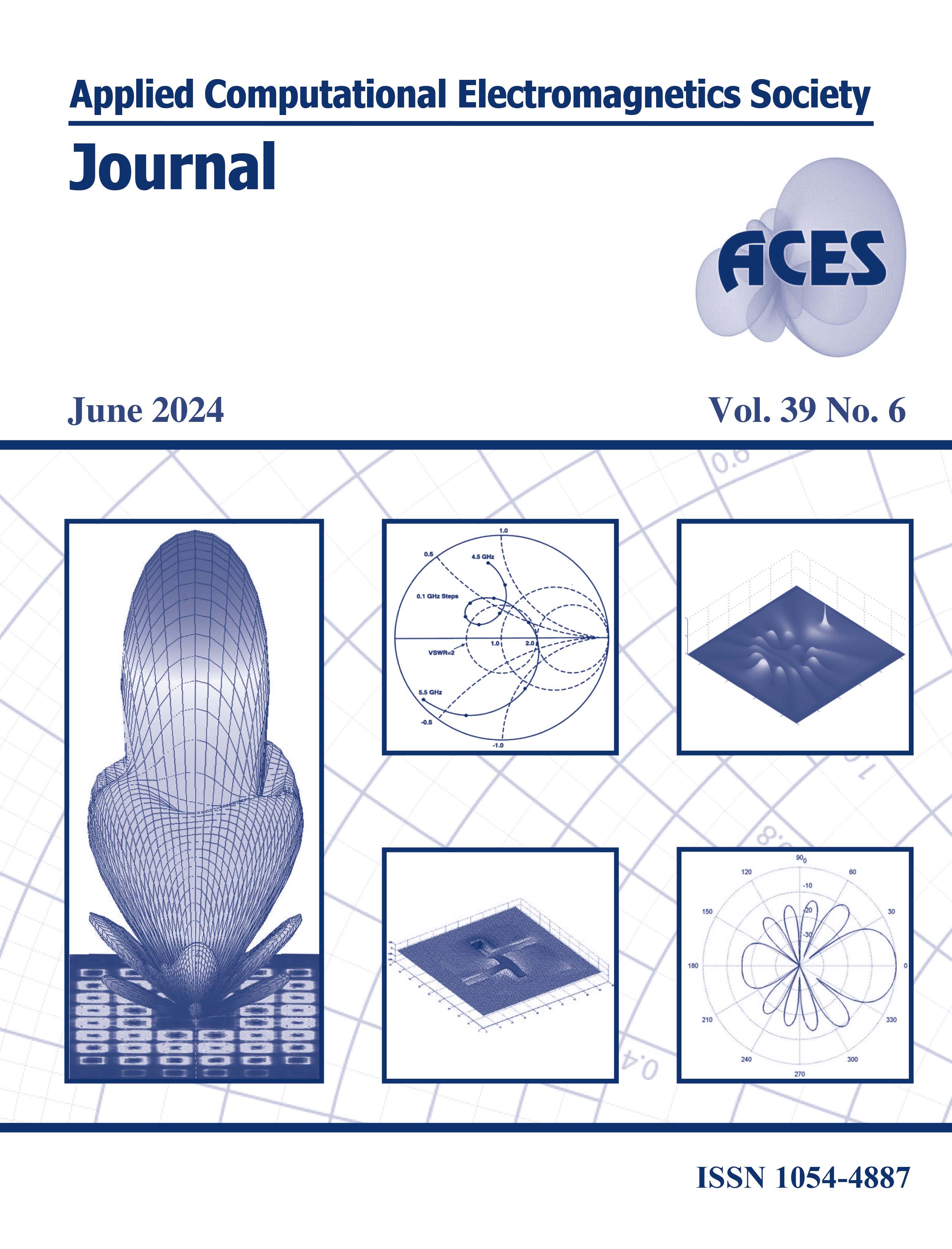Analysis of Reader Orientation on Detection Performance of Hilbert Curve-based Fractal Chipless RFID Tags
DOI:
https://doi.org/10.13052/2024.ACES.J.390603Keywords:
Angle of incidence, Chipless RFID, coding den, fractal tags, RFID readersAbstract
The role of the orientation of the radio frequency identification (RFID) reader is vital in the RFID-based communication system. This study presents the design and analysis of the impact of the orientation of the RFID reader (angle of incidence of the plane wave) on the detection and sensitivity characteristics of fractal chipless RFID tags. Four fractal (irregular) shaped tags are developed using four iterations of the Hilbert curve filling algorithm. The full-wave EM analysis of the designed tags in Matlab is performed by exporting them in Computer Simulation Technologies Micro-Wave Studio (CST MWS) in the frequency range of 2 to 20 GHz. Firstly, the performance of the tags is analyzed by observing the radar cross-section (RCS) of the tag for the fixed orientation of the incident plane wave in three different polarizations (horizontal, vertical, and oblique). Later, the variations in the EM spectrum (RCS results) are analyzed for oblique polarization by varying the incidence plane wave in both elevations (for two cases of 0∘ and 90∘) and azimuth planes (sweeping from 0∘ to 180∘ with a step size of 10∘). The analysis of the proposed aggregated RCS response for all cases in oblique polarization produces higher coding capacity (169 bits), coding spatial capacity (16.504 bits/cm2), coding spectral capacity (9.826 bits/GHz), and coding density (0.960 bits/GHz/cm2) for the realized highly irregular tag using fourth-iteration (4T) of Hilbert curve filling algorithm. The proposed procedure of detection based on aggregated response makes the developed RFID communication system more secure and reliable.
Downloads
References
Q. H. Sultan and A. M. Sabaawi, “Design and implementation of improved fractal loop antennas for passive UHF RFID tags based on expanding the enclosed area,” Progress in Electromagnetics Research C, vol. 111, pp. 135-145, 2021.
M. Borgese, S. Genovesi, G. Manara, and F. Costa, “Radar cross section of chipless RFID tags and BER performance,” IEEE Transactions on Antennas and Propagation, vol. 69, no. 5, pp. 2877-2886, 2021.
H. Rmili, B. Oussama, J. Yousaf, B. Hakim, R. Mittra, T. Aguili, and S. Tedjini, “Robust detection for chipless RFID tags based on compact printable alphabets,” Sensors, vol. 19, no. 21, p. 4785, 2019.
C. Herrojo, M. Moras, F. Paredes, A. Nunez, E. Ramon, J. Mata-Contreras, and F. Martin, “Very low-cost 80-bit chipless-RFID tags inkjet printed on ordinary paper,” Technologies, vol. 6, no. 2, 2018.
K. Issa, Y. Alshoudokhi, M. Ashraf, M. Alshareef, H. Behairy, S. Alshebeili, and H. Fathallah, “A high-density L-shaped backscattering chipless tag for RFID bistatic systems,” International Journal of Antennas and Propagation vol. 2018, p. 10, 2018.
L. M. Arjomandi, G. Khadka, Z. Xiong, and N. C. Karmakar, “Document verification: A cloud-based computing pattern recognition approach to chipless RFID,” IEEE Access, vol. 6, pp. 78007-78015, 2018.
H. Rmili, D. Oueslati, L. Ladhar, and M. Sheikh, “Design of a chipless RFID tags based on natural fractal geometries for security applications,” Microwave and Optical Technology Letters, vol. 58, no. 1, pp. 75-82, 2016.
H. Huang and L. Su, “A compact dual-polarized chipless RFID tag by using nested concentric square loops,” IEEE Antennas and Wireless Propagation Letters, vol. 16, pp. 1036-1039, 2017.
M. Polivka, J. Havlicek, M. Svanda, and J. Machac, “Improvement in robustness and recognizability of RCS response of U-shaped strip-based chipless RFID tags,” IEEE Antennas and Wireless Propagation Letters, vol. 15, pp. 2000-2003, 2016.
O. Necibi, S. Beldi, and A. Gharsallah, “Design of a chipless RFID tag using cascaded and parallel spiral resonators at 30 GHz,” in 2015 2nd World Symposium on Web Applications and Networking (WSWAN), pp. 1-5, 2015.
J. Y. Mohammad, N. Zaqumi, M. Zarouan, M. A. Hussaini, and H. Rmili, “Passive fractal chipless RFID tags based on cellular automata for security applications,” Applied Computational Electromagnetics Society (ACES) Journal, vol. 36, no. 5, pp. 559-567, May 2021.
E. Motovilova and S. Y. Huang, “Hilbert curve-based metasurface to enhance sensitivity of radio frequency coils for 7-T MRI,” IEEE Transactions on Microwave Theory and Techniques, vol. 67, no. 2, pp. 615-625, 2019.
M. E. Mousa, H. H. Abdullah, and M. E. d. A. El-Soud, “Compact chipless RFID tag based on fractal antennas and multiple microstrip open stub resonators,” in 2018 Progress in Electromagnetics Research Symposium (PIERS-Toyama), pp. 1332-1338, 2018.
L. Wang, T. Liu, J. Sidén, and G. Wang, “Design of chipless RFID tag by using miniaturized open-loop resonators,” IEEE Transactions on Antennas and Propagation, vol. 66, no. 2, pp. 618-626, 2018.
M. Alibakhshi-Kenari, M. Naser-Moghadasi, R. A. Sadeghzadeh, B. S. Virdee, and E. Limiti, “Dual-band RFID tag antenna based on the Hilbert-curve fractal for HF and UHF applications,” IET Circuits, Devices & Systems, vol. 10, no. 2, pp. 140-146, 2016.
N. A. Murad, M. Esa, M. F. M. Yusoff, and S. H. A. Ali, “Hilbert curve fractal antenna for RFID application,” in 2006 International RF and Microwave Conference, pp. 182-186, 2006.
J. McVay, A. Hoorfar, and N. Engheta, “Space-filling curve RFID tags,” in 2006 IEEE Radio and Wireless Symposium, pp. 199-202, 2006.
L. Velho and J. D. M. Gomes, “Digital halftoning with space filling curves,” Proc. Of the 18th
ann. Conf. on Computer Graphics and Interactive Techniques, vol. 25, no. 4, pp. 81-90, 1991.
Y. Watanabe and H. Igarashi, “Shape optimization of chipless RFID tags comprising fractal structures,” International Journal of Applied Electromagnetics and Mechanics, vol. 52, no. 1-2, pp. 609-616, 2016.




